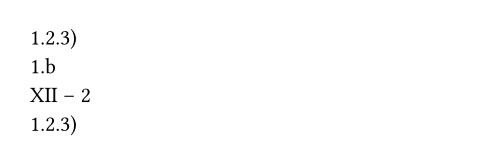numbering
Applies a numbering to a sequence of numbers.
A numbering defines how a sequence of numbers should be displayed as content. It is defined either through a pattern string or an arbitrary function.
A numbering pattern consists of counting symbols, for which the actual number is substituted, their prefixes, and one suffix. The prefixes and the suffix are repeated as-is.
Example
#numbering("1.1)", 1, 2, 3) \
#numbering("1.a.i", 1, 2) \
#numbering("I – 1", 12, 2) \
#numbering(
(..nums) => nums
.pos()
.map(str)
.join(".") + ")",
1, 2, 3,
)

参数
参数是函数的输入,它们在函数名称后面的括号中传入。
numbering
Defines how the numbering works.
Counting symbols are 1, a, A, i, I, い, イ, א, 가,
ㄱ, and *. They are replaced by the number in the sequence, in the
given case.
The * character means that symbols should be used to count, in the
order of *, †, ‡, §, ¶, and ‖. If there are more than six
items, the number is represented using multiple symbols.
Suffixes are all characters after the last counting symbol. They are repeated as-is at the end of any rendered number.
Prefixes are all characters that are neither counting symbols nor suffixes. They are repeated as-is at in front of their rendered equivalent of their counting symbol.
This parameter can also be an arbitrary function that gets each number
as an individual argument. When given a function, the numbering
function just forwards the arguments to that function. While this is not
particularly useful in itself, it means that you can just give arbitrary
numberings to the numbering function without caring whether they are
defined as a pattern or function.
numbers
The numbers to apply the numbering to. Must be positive.
If numbering is a pattern and more numbers than counting symbols are
given, the last counting symbol with its prefix is repeated.